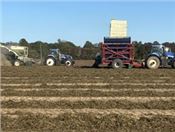|
Slow Start, Strong Finish For Arkansas Peanuts

Peanuts can be a frustrating crop to get into, with added sensitivity to weather, and the slow process of harvest.
Nevertheless, peanuts are enjoying increasingly popularity in eastern Arkansas, gradually expanding into the southern part of the Delta region.
Division of Agriculture photo
PARAGOULD, ARK.
Despite a plant-then-replant start, the 2020 Arkansas peanut growing season ended with a smoother harvest than in previous years thanks to weather and a couple of new buying points, Andy Vangilder, an extension educator for the University of Arkansas System Division of Agriculture, said.
The season was also marked by peanuts’ expansion out of northeastern and east central Arkansas, adding interest and at least one grower in southeastern Arkansas.
Early planting
“Early season weather allowed growers to get in the field and some took the risk and planted early,” Vangilder said. Then, however, the rains came.
“Wet and cool weather followed, forcing some to add more seed in the field and some replanted altogether,” he said. “I would say 10 to 15 percent had to replant.
“After that, the weather straightened up and things started looking better,” Vangilder said. “Weather is a challenge for people who are going into the peanut industry. The crop is more dependent on the weather. At harvest, you won’t ‘mud’ those peanuts out,” but need to wait until conditions are drier.
Arkansas planted some 37,000 acres in peanuts in 2020, up from last year’s 33,000. Chief counties for peanut production in 2020 were Chicot, Clay, Craighead, Greene, Lawrence, Lee, Mississippi, Phillips, Poinsett, Randolph and St. Francis.
Slow harvest
When harvest began, it appeared yields might be down.
“Those first peanuts didn’t really grow off well. They had thin stands and didn’t have the best yield potential,” Vangilder said. “The first yields came in at around 4,000 to 4,500 pounds per acre and steadily increased to the 5,500-pounds-per-acre-and-better range.”
However, estimating final yields can be difficult. The National Agricultural Statistics Service, part of the U.S. Department of Agriculture, will have final yield and harvest numbers for Arkansas commodities in January.
Thanks to new buying points at Jonesboro and Marianna, plus the already existing points at Pocahontas and Portia, “harvest went much smoother,” Vangilder said. “There was no waiting on trucks and producers could harvest when they needed to.”
Peanuts moving south
Vangilder said there were four new growers in Clay County alone in 2020, and one new grower in Chicot County.
“I visited with several producers down around Tiller who are considering growing peanuts,” he said. “They’re watching to see how the crop there goes.”
Because peanuts are not a friendly crop to the nematodes that plague cotton, rotating the legume has proven a boon for cotton growers.
Expanded research
Vangilder said 2020 had another upside. This year he was able to get peanut trials off the ground.
“We focused on three areas: variety testing, plant growth regulators and incorporating gypsum,” he said. Gypsum applied to the soil provides needed calcium to peanut plants.
“For us in extension, this was our first year we were able to go to get large block trials and get peanut data,” he said, adding that these large block trials were in addition to the small block trials being conducted by Travis Faske, extension plant pathologist. Faske doubled as an extension resource for peanut growers for several years before Vangilder returned to the Cooperative Extension Service.
As trials expanded across different counties, so did the knowledge base of county agents. He said he appreciated working alongside Mike Andrews in Randolph County, Bryce Baldridge and Courteney Sisk in Lawrence County, Chris Grimes in Craighead County and Allison Howell in Clay County.
“I want to give a shout out to the producers who worked with us this year,” Vangilder said, adding that the pace of work in peanut growing can be a challenge for producers new to the crop.
“Everything you do with peanuts is slow. Planting. Digging, slow harvest,” he said. “You can run 5 to 8 miles per hour to combine beans. It’s more like 0.8 to 1.6 miles per hour for peanuts.”
Research was aided by the purchase of a weigh wagon for the 2020 season to help gauge yields, as well as funding from the Arkansas Peanut Board for research into weed, insect and disease pests.
Vangilder expressed some disappointment about variety trials in 2020.
“While we were able to have variety tests in the high oleic varieties, I was disappointed not to be able to get seed to have a standard variety test especially having a grower wanting to do the test,” he said.
These trials are important to producers because they can show which varieties are best suited for Arkansas’ growing conditions.
“It’s hard to have a variety trial with just one variety,” he said, adding that he hoped the seed situation might be better for 2021.
Next year, Vangilder is looking forward to seeing research expand again.
“We’ll do irrigation timing studies next year with Mike Hamilton,” extension irrigation instructor for the Division of Agriculture, he said.
To learn more about peanut production, contact your county extension office. ∆
|
|